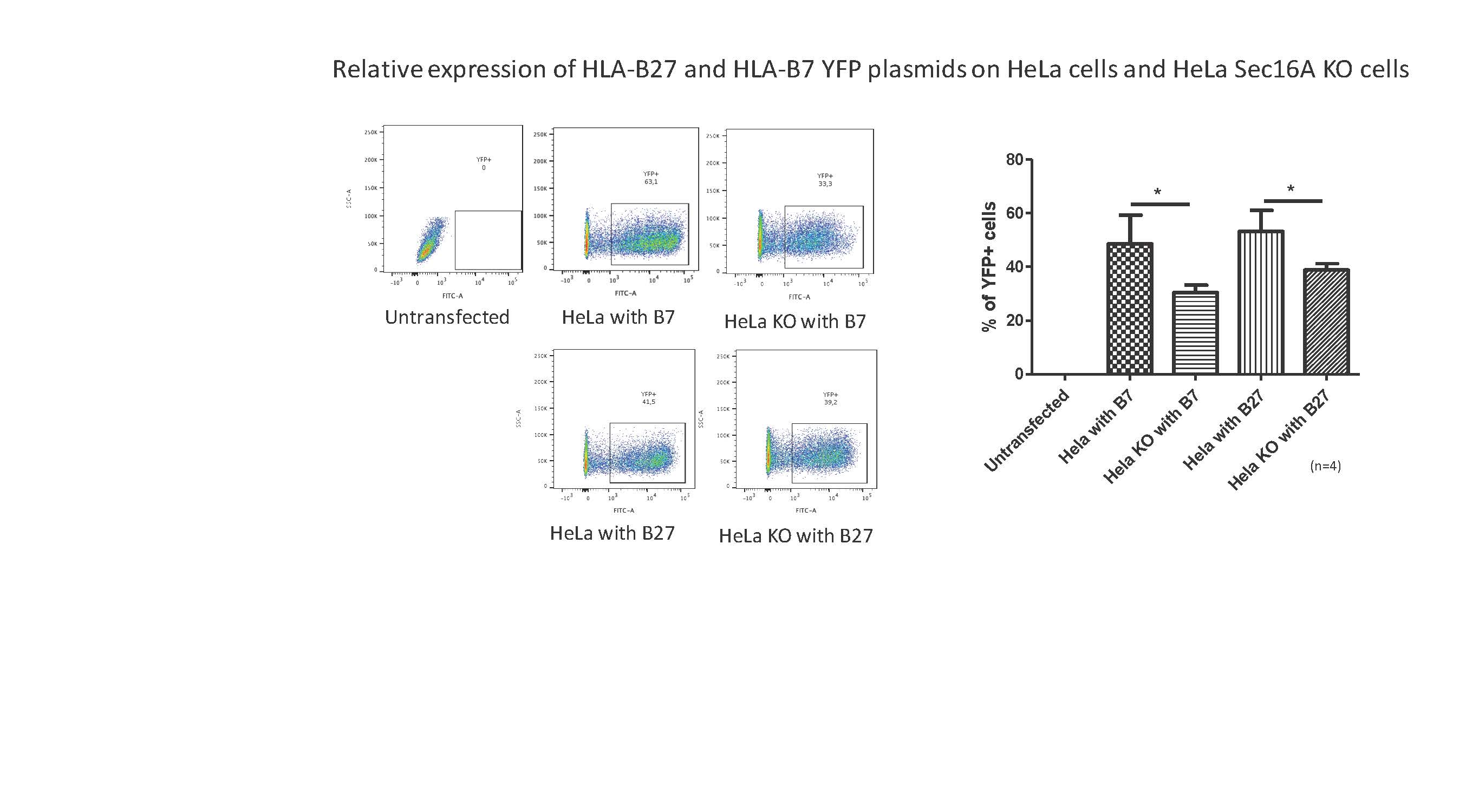Session Information
Session Type: Poster Session (Sunday)
Session Time: 9:00AM-11:00AM
Background/Purpose: Axial Spondyloarthritis (AxSpA) is a chronic inflammatory arthritis, mainly affecting the axial skeleton. HLA-B27 confers the greatest genetic association in AxSpA. Exome sequencing in a multiplex family had revealed that the incidence of AxSpA in individuals with HLA-B27 and the Sec16A mutation was 100%. Sec16A is a protein that plays a major role in the formation of COPII vesicles and trafficking of proteins from ER to plasma membrane via Golgi Complex. We had previously shown that Sec16A abnormalities not only hinder the assembly of COPII vesicles, leading to abnormal intracellular trafficking and ER stress but also it disrupted the HLA-B27 expression. Here, we aim to investigate whether the Sec16A abnormalities affect the intracellular trafficking of HLA-B27, which is associated with the development of AxSpA, differ from those of HLA-B7, which is not associated. In addition, examining the effect of top 10 interacting proteins of Sec16A, previously identified using BioID, by next generation sequencing help us understanding the pathway associated with intracellular trafficking of HLA-B27.
Methods: Sec16A knockout HeLa cells were generated by transfecting these cells with Sec16A CRISPR/Cas9 KO plasmid (h) and Sec16A HDR plasmid (h) according to manufacturer’s instructions. KO efficiency was determined by western blotting. The plasmids encoding YFP (Yellow Fluorescent Protein) tagged HLA-B27 and HLA-B7 were transfected to HeLa cells and HeLa Sec16A KO cells. The YFP expression of HLA-B7 and HLA-B27 in HeLa cells was assessed by flow cytometry and confocal microscopy at different time points. The real time intracellular trafficking of HLA was monitored using live cell imaging. Also, the expression of properly folded and misfolded HLA-B7 and HLA-B27 were determined using flow cytometry. The top 10 proteins interacting with Sec16A were suppressed using siRNA in C1R-B27 cells and their effect were studied using Next Generation Sequencing.
Results: There was a significant decrease in the expression of both HLA-B7 (p< 0.05) and HLA-B27 (p< 0.05) in the HeLa Sec16A KO cells compared to wild type cells after transfection. HeLa cells showed an intracellular accumulation of HLA-B27 and HLA-B7 as a result of over expression. On the other hand, we did not observe any such vesicle formation in the HeLa Sec16A KO cells. Sec16 KO cells exhibit an exaggerated unfolded protein response resulting in degradation of the HLA-B proteins. This is also evident from the increased level of intracellular misfolded HLA-B27 and HLA-B7 in the Sec16 KO cells. Using next generation sequencing, we found that Sec16A interacting proteins had an effect in the pathways related to inflammation, ER-to-Golgi vesicle mediated transport and antigen presentation.
Conclusion: Sec16A plays a significant role in the trafficking of HLA-B molecules (HLA-B7 and HLA-B27) irrespective of the subtypes, thereby playing a prospective role in the pathogenesis of AxSpA.
To cite this abstract in AMA style:
Talukdar A, Zeng F, Zhang Z, Haroon N. Sec16A Abnormalities Affect the Intracellular Trafficking of HLA-B27 in the Pathogenesis of Axial Spondyloarthritis [abstract]. Arthritis Rheumatol. 2019; 71 (suppl 10). https://acrabstracts.org/abstract/sec16a-abnormalities-affect-the-intracellular-trafficking-of-hla-b27-in-the-pathogenesis-of-axial-spondyloarthritis/. Accessed .« Back to 2019 ACR/ARP Annual Meeting
ACR Meeting Abstracts - https://acrabstracts.org/abstract/sec16a-abnormalities-affect-the-intracellular-trafficking-of-hla-b27-in-the-pathogenesis-of-axial-spondyloarthritis/


